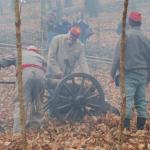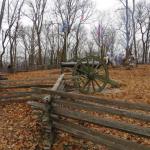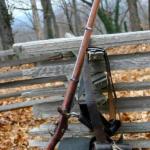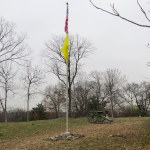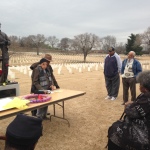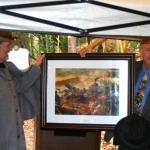Saturday, December 13, 2014
Monday, December 15, 2014
Tuesday, December 16, 2014
Nashville Remembers:
CITY-WIDE COMMEMORATION OF THE BATTLE OF NASHVILLE SESQUICENTENNIAL
On Saturday, December 13, 2014, the city of Nashville paid homage to one of the most important events in its history — the 150th anniversary of the Battle of Nashville — with three days of events dedicated to a remembrance and commemoration of the war.
Historic venues all across the city, united under a multi-member task force, invited visitors to visit their buildings and grounds to see living history demonstrations, reenactors who camped in some areas overnight, tours, lectures, music, and the firing of cannons.
In the end, hundreds had come on the gray, cold Saturday of December 13, 2014, to remember the two-day bloody battle that marked the last major battle of the American Civil War.
 The day-long programs of December 13 were followed by events honoring the United States Colored Troops on Monday, December 15, and by the emotional placing of the Memorial Wreath on Shy’s Hill by descendants of the soldiers, and the city-wide tolling of church bells, on Tuesday, December 16.
The day-long programs of December 13 were followed by events honoring the United States Colored Troops on Monday, December 15, and by the emotional placing of the Memorial Wreath on Shy’s Hill by descendants of the soldiers, and the city-wide tolling of church bells, on Tuesday, December 16.
All of the programming was in honor and memory of December 15 and 16, 1864, when Nashvillians could stand on the hills outside of Nashville and actually watch two seasoned generals, John Bell Hood for the South and George Thomas for the North, engage each other in a desperate battle that was waged over ground where the descendants of those former spectators now live and shop. Thousands of men were killed or wounded in the battle that resulted in a rout of the Confederate Army, and the end of the war a few months later in 1865.
On December 13, 2014, eleven Civil War historic sites in the Nashville area hosted living history demonstrations with Confederate and Union reenactors and cannon firings. Several locations organized special exhibitions and events to mark the sesquicentennial anniversary of this important battle. The day’s events ended at 4:30 p.m. when all locations with cannons fired several volleys to mark the occasion.
“This December marks 150 years since war struck the heart of our city,” said Nashville Mayor Karl Dean. “This anniversary provides us with an occasion to showcase Nashville’s important historic sites for our residents and visitors who may not be familiar with the rich Civil War history we have here. I am proud to see so many people working together to commemorate and interpret an important time in our nation’s history.”
Below are photographic depictions of the various memorials which occurrd on grounds owned and maintained by The Battle of Nashville Preservation Society:
December 13, 2014
SCENES FROM SHY’S HILL
The steep, slippery hill in which the Union forces swept the Confederate left flank from the field of battle and effectively ended the Battle of Nashville drew heavy crowds on Saturday, Dec. 13, as numerous reenactors, camping on the summit, explained the battle to new visitors and a howitzer boomed from the eastern slope every hour. Below are some of the images from the day’s events.

Cannon fire reminds Nashville of sounds that echoed in its hill 150 years ago. (Photo by Todd Lawrence) See video below (by Tom Lawrence)
Video: Shy’s Hill cannon reminds Nashville of its past
Photo Gallery
Photographers contributing to galleries below include Elaine Kay, Todd Lawrence, Sidney McAlister and Tom Lawrence
- Reenactors around campfire at Shy's summit
- Howitzer fires its 3:00 p.m. round
- BONPS president John Allyn at the Shy's trailhead
- Howtizer ready for action
- Top of Shy's Hill
- Confederate reenactors
- Jim Kay & John Allyn of BONPS
- "Private" Sean Ryan, son of Mr. & Mrs. Phil Ryan
December 13, 2014
SCENES FROM REDOUBT NO. 1
Redoubt No. 1, located on Benham Avenue, was the last of the Confederate Army’s five earthen forts to fall. Federal troops enveloped it late in the afternoon of December 15, 1864, attacking from the west and north. The Redoubt’s 150 men and four artillery pieces were no match for the overwhelming tide of blue that swept over them that day.
After the first day’s battle, the redoubt was converted into a field hospital and contemporary artists’ renderings show it flying the yellow hospital flag. BONPS, which owns the property, flew the yellow flag during the December 13 commemoration, during which several Federal reenactors and a Confederate “prisoner of war” imparted their knowledge of the battle and their gear to dozens of visitors.
- Reenactors at Redoubt 1 (L to R) Tyler Sneed, Jeremy Johnson, Bart Boaz and Rick Hoover)
- Reenactors' gear on ground cloth at Redoubt 1
- The view north from Redoubt 1
- Redoubt No. 1 flying yellow field hospital flag
- Various flags at Redboubt 1
- Reeanctors warm by campfire and chat with visitors
Monday, December 15, 2014
USCT Honored In Special Ceremony
 A ceremony commemorating the African American soldiers who fought in the Battle of Nashville was held at the Nashville Natlional Cemetery located at 1420 Gallatin Pike S in Madison on Monday, December 15, 2014. For details, see the poster at left (click to enlarge).
A ceremony commemorating the African American soldiers who fought in the Battle of Nashville was held at the Nashville Natlional Cemetery located at 1420 Gallatin Pike S in Madison on Monday, December 15, 2014. For details, see the poster at left (click to enlarge).
Some 12,769 Civil War-era soldiers (Union) are buried at the National Cemetery, including members of the United States Colored Troops (USCT) who fought on both days of The Battle of Nashville at Granbury’s Lunette and Peach Orchard Hill.
The Dec. 15 event took place near the bronze statue dedicated in 2006 to the United States Colored Troops. This is the only free standing monument of a USCT soldier in the United States. Sculptor Roy W. Butler used William Radcliffe of the 13th USCT as a model for the statue. For more on the National Cemetery and the USCT soldiers there, see the BONPS website feature story with photos and text.

BONPS Board member Gary Burke (Left) and Bill Radcliffe at the USCT memorial on December 15, 2014 (Photo by Sidney McAlister)
Photos below taken by BONT Vice President Sidney McAlister:
Monday, December 16, 2014
Shy’s Hill Annual Memorial Wreath Ceremony and Tolling of Bells
 Hosted by The Battle of Nashville Preservation Society, the annual Memorial Wreath began at 3:30 p.m. with a recounting of the battle by Jim Kay, and the placing of the wreath by descendants of the Union and Confederate soldiers at the Shy’s Hill Flag Memorial. As always, BONPS invited descendants and their families to come to the top of Shy’s Hill and to participate in the wreath ceremony.
Hosted by The Battle of Nashville Preservation Society, the annual Memorial Wreath began at 3:30 p.m. with a recounting of the battle by Jim Kay, and the placing of the wreath by descendants of the Union and Confederate soldiers at the Shy’s Hill Flag Memorial. As always, BONPS invited descendants and their families to come to the top of Shy’s Hill and to participate in the wreath ceremony.
At 4:30 to 4:34 p.m. — the approximate time at which Shy’s Hill was overrun by Federal Troops to end the battle — Nashville churches and schools around all parts of the city tolled their bells to commemorate this historic event.
Click HERE to see and listen to a moving video created by Mary Newton and her talented team at Nashville.gov’s Channel 3.
Click below to see a short video of the crowd atop Shy’s Hill honoring the fallen combatants of the Battle of Nashville as the city’s church bells rang out (turn volume up to hear the bells) (Video by Tom Lawrence)
Summit of Shy’s Hill falls silent as visitors listen to Nashville’s church bells

Above: Representatives of the Northern and Southern forces together placed the Memorial Wreath on Shy’s Hill on December 16, 2014 — exactly 150 years from the afternoon of the decisive battle which ended the conflict. Placing the wreath are Ken Flies of Minnesota, a member of the task force responsible for placement of the Minnesota Monument on Shy’s Hill, and Tom Lawrence, a member of the BONPS Board whose great grandfather fought in the battle of Nashville. (Photo by Fred Crown)
Remembering 150 Years: Ed Bearss Comes To Nashville
 On Tuesday, December 16, 2014, the Battle of Nashville Preservation Society and Travellers Rest hosted speaker Ed Bearss on the 150th Anniversary of the Battle of Nashville.
On Tuesday, December 16, 2014, the Battle of Nashville Preservation Society and Travellers Rest hosted speaker Ed Bearss on the 150th Anniversary of the Battle of Nashville.
On this same day in 1864, the United States army decisively defeated the Confederate army in the last major battle of the Civil War in the west. This presentation is part of the 150th Sesquicentennial Civil War Ceremonies to commemorate and remember the Battle of Nashville.
Mr. Bearss is the most noted speaker on the Civil War and is still giving tours at age 91. Jim Kay, treasurer of the Battle of Nashville Preservation Society noted that “we are so pleased to have Ed come to Nashville.” The event at Travellers Rest was sold out, and the Sesquicentennial commemoration of the Battle of Nashville came to an end. “It was a great finale to our preservation efforts,” Kay said.
Below are photos of the Travellers Rest event, taken by Elaine Kay:
November 14, 2014
PANEL OF CIVIL WAR EXPERTS DISCUSS JOHN BELL HOOD’S TENNESSEE CAMPAIGN
As part of the Battle of Nashville Sesquicentennial events, the Tennessee Sesquicentennial Commission hosted a panel discussion with three of the most distinguished authors and historians in the field – James Lee McDonough, Wiley Sword, and Christopher Losson.

Above: Speakers James Lee McDonough, Wiley Sword and Chris Losson discuss the 1964 Tennessee Campaign.
The presentation occurred in Franklin and included the speakers’ collective analysis of the Army of Tennessee in November and December of 1864, covering such issues as Gen. Hood’s handling of the campaign and the importance of the United States Colored Troops in Nashville. To see the entire 90-minute discussion, click on the photo above.
Professor McDonough, a Nashvillian, has authored numerous books on the Civil War, including Nashville: The Western Confederacy’s Final Gamble. Wiley Sword is also the author of numerous books on the topic, including The Confederacy’s Last Hurrah: Spring Hill, Franklin, and Nashville and Embrace An Angry Wind, both focused on Nashville. Historian Chris Losson is known for his book Tennessee’s Forgotten Warriors: Frank Cheatham and his Confederate Division.
List of sites which featured living history events:
Shy’s Hill:
This is one of two Battle of Nashville Preservation Society (BONPS) sites, located just off Harding Place on Benton Smith Road. Here, Confederate entrenchments atop Shy’s Hill were assaulted by Union troops on December 16, 1864. The Confederate defenders found themselves fighting a three front battle as Union cavalry got behind their positions and destroyed the left end of the Confederate line. Join Confederate and Union infantry soldiers as they tell the story of attacking and defending this crucial point of the Confederate line.
Redoubt No. 1:
The second BONPS site, on Benham Avenue near the intersection of Woodmont Blvd. and Hillsboro Rd., is on the Confederate line looking north toward Nashville. Here, in an effort to besiege the Union Army in Nashville, the Confederates built a series of earthworks covering the southern approaches to the city. These works included a number of strong points with artillery called redoubts. The redoubts were overrun by the attacking Union troops on December 15, 1864. A small group of Union soldiers will interpret their actions as they stand guard over Confederate prisoners captured during the first day of battle.
Belle Meade Mansion:
As the headquarters for Confederate General Chalmers, who commanded a portion of Forrest’s cavalry, Belle Meade Mansion played an important role in the Battle of Nashville. Belle Meade experienced a cavalry battle between Chalmer’s men and the Union Cavalry on December 15, 1864. Living history interpreters will provide programs on both the Union and Confederate cavalry on the grounds of Belle Meade. The site will also feature an artillery demonstration. 5025 Harding Pike.
Belmont Mansion:
Headquarters of Union General Thomas J. Wood and his staff, who used Belmont Mansion’s cupola to observe the Battle of Nashville. Living history interpreters depicting the staff of General Wood will be on hand to discuss the role of Belmont in the battle. Several rooms in the house will also be set up to reflect the presence of the Union soldiers. 1700 Acklen Ave.
Bicentennial Mall State Park:
Nashville became not only a major supply center and transportation hub for the Union Army, but also a destination for thousands of refugees, both white and black, who were displaced by the war. Join civilian living history interpreters as they relate the stories of survival in the midst of a war that impacted thousands of civilians. The visitor’s center at the Bicentennial Mall also features an exhibit on the Civil War in Tennessee. 600 James Robertson Pkwy.
Fort Negley:
The largest of the Union fortifications built to defend Nashville, Fort Negley was built by former slaves hired by the army. The living history programs at Fort Negley will include Union artillery and infantry demonstrations as well as the US Signal Corps and United States Colored Troops. 1100 Fort Negley Blvd.
The Land Trust for Tennessee’s Glen Leven Farm:
Situated between the main Union and Confederate lines, The Land Trust for Tennessee’s Glen Leven Farm was within cannon shot of Fort Negley. Union troops, including an entire division of United States Colored Troops, marched across the farm as they attacked the Confederate lines on December 16, 1864. The home was used as a Union hospital in the immediate aftermath of the fighting. Visitors to Glen Leven can interact with interpreters portraying Union surgeons to learn about typical Civil War medical practices. An exhibit on Glen Leven during the Civil War will also be available for viewing. 4000 Franklin Pike.
Sevier Park:
The home located in Sevier Park was called Sunnyside. It was built in the 1840s and was the home of Mary Benton, widow of Jesse Benton. The home sat between the lines and Union troops marched past the house to assault Confederate positions during the two day battle. In the days after the fighting, the home was used as a hospital. Today Sunnyside serves as the offices for the Metro-Nashville Historical Commission. Visitors may visit with Union artillerymen and learn about the firing of Civil War cannon. 3021 Lealand Lane
Travellers Rest:
As the headquarters of General John Bell Hood, the overall commander of Confederate forces, Travellers Rest served a pivotal role in the Battle of Nashville. The site will recreate the look and feel of the “nerve center” of an army on active campaign. Living history volunteers will depict couriers on horseback, staff officers carrying out the operations of an army, and an infantry squad serving as headquarters guard. The headquarters functioned in the midst of the Overton family who still resided in the house. The interaction between soldiers and civilians will be depicted as well as Confederate artillery and typical music of the common soldier. Visitors may also visit the exhibition on the Civil War at Travellers Rest. 636 Farrell Pkwy.
Special Exhibitions:
Tennessee State Library and Archives: Visit the Tennessee State Library and Archives temporary exhibit on the year 1864. On view in the lobby, this exhibit will discuss this crucial year of the war that culminates with the destruction of the Confederate army at Nashville. The exhibit also includes information on how to trace your Civil War ancestor. 403 7th Ave., North.
Tennessee State Museum: A temporary exhibit will be on view where visitors will learn about the lives of civilians during military occupation, many challenges confronting women on the home front, and the soldiers who fought in the battle. A cyclorama study of the Battle of Nashville will also be on display. Museum staff will be on site to give tours of the exhibit and of its permanent collection of Civil War holdings of uniforms, battle flags and weapons, which are among the finest in the nation. 505 Deaderick Street. 615-741-2692.
Battle of Nashville Commemorative Sesquicentennial Coin
BONPS has minted a distinctive “Collector’s Edition” coin to commemorate the 150th anniversary of the Battle of Nashville. The Sesquicentennial medallion is 1.5 inches in diameter and struck from antique brass. It comes in a clear plastic display box.
Proceeds from purchase of the coin, which is being made available a year in advance of the Battle’s Sesquicentennial commemoration on December 15 – 16, 2014, will be used by BONPS in its continuing efforts to acquire and preserve remnants of the 1864 battlefield located in South Nashville.
TENNESSEE STATE MUSEUM DISPLAYS BATTLE CYCLORAMA
The State Museum’s temporary exhibit (see above) will feature a cyclorama study of the Battle of Nashville. Museum staff will be on site to give tours of the exhibit and of its permanent collection of Civil War holdings of uniforms, battle flags and weapons, which are among the finest in the nation.
The image above is taken from a color study that was made for a full scale cyclorama of the Battle of Nashville by Louis Kindt in about 1884, some 20 years after the battle. Unfortunately, no one ever commissioned a finished work, but this study will be on loan for the duration of this exhibition at the Tennessee State Museum. It is painted to be a closed circle, with the viewer standing at the present-day intersection of Hillsboro Pike and Woodmont Blvd. Redoubt No.1 is seen with a yellow field hospital flag flying over it. Fort Negley is also seen in the background.
Another section of the cyclorama is shown above. This section illustrates the intense fighting that took place along Hillsboro Pike in the present Green Hills Mall area of Nashville.
Sunday, November 16, 2014
MINNESOTA MONUMENT DEDICATED ON SHY’S HILL
On Sunday, November 16, 2014, in a drizzling rain reminiscent of December 16, 1864, a granite monument was dedicated on the northeastern slope of Shy’s Hill in memory of the 97 Minnesota troops who died in a bloody but successful uphill charge there 150 years ago. It was the first such monument placed on any part of the Battle of Nashville battlefield to specifically commemorate Union troops.
Click HERE to view the Minnesota Historical Society’s video describing the Minnesota monument, the dedication ceremony and the important role played by Minnesota troops in the battle at Shy’s Hill.
The unveiling and dedication of the monument was one of the many events which make up the commemoration of the Battle of Nashville Sesquicentennial. It was jointly hosted by the Minnesota Civil War Commemoration Task Force and The Battle of Nashville Preservation Society (BONPS). The monument had been placed by crane on November 3, 2014, with the help of BONPS board member Parke Brown and others.
A contingent of Minnesotans traveled the 900 miles to Nashville to participate in the dedication ceremony. For a closer look at the importance of the monument to the people of Minnesota, read “Eloquence At The Battle of Nashville,” an article published on November 8, 2014, in the Minneapolis Star Tribune by columnist Curt Brown, describing the long bus journey southward, its meaning to the State of Minnesota, and the story behind the moving inscription on the face of the new monument (Note: The article inadvertently reports the number of Minnesota casualties at 87 rather than the actual 97).
The dedication event and the monument itself highlighted the Battle of Nashville and the pivotal role played by the four Minnesota regiments on December 16, 1864. On that day, under orders given in the late afternoon of the rainy day by Brig. Gen. John McArthur, the four regiments made the decisive charge up Shy’s Hill, collapsing the Confederate line and becoming the pivotal moment in what is considered the last major battle of the Civil War.
Under the rain-soaked tents during the dedication, numerous speakers lent perspective to the Shy’s Hill fighting and the meaning of the monument, which marks the bloodiest single day of the war for Minnesota troops.
Among them was Ken Flies, whose great-great-grandfather fought in the Tenth Minnesota Infantry and died in Tennessee. He is chairman of the Soldier Recognition Committee of the Minnesota Civil War Commemoration Task Force which initiated the Monument concept. The Committee worked jointly with the Battle of Nashville Preservation Society along with the Land Trust for Tennessee, organizations which have been instrumental in saving many of the major sites of the Nashville battlefield.
During his remarks, Ken read aloud the inscription on the monument, which was written by a Minnesota private, John Milton Benthall, in a document which Ken discovered in his meticulous research of the battle:
“… comrades who have grown as dear to us as brothers lie dotting the steep hillside, their battles ended, their warfare over. Never more will they press with us shoulder to shoulder as the bristling steel points sweep resistlessly on, never more in our hours of glee will their voices join in the merry jest or fill the air with laughter — they are gone. And the everlasting mountains in the shadow of which they lie shall be their eternal monument; year after year the forest trees will shed their crowns of glory over them, and day by day the winds, as they sigh through the Brentwood Hills, will chant a low, sad requiem to their memory.”
The story of how Ken discovered the author of the report from which these words were taken is a story of tenacious historical investigation and persistence. He tells the story in the article below, and along with it, has provided BONPS with a copy of the actual report by Private Benthall:
Jacob Milton Benthall Biography
The Tenth Minnesota News
Other speakers included a welcome by John Allyn, president of BONPS, and Ann Toplovich, executive director of the Tennessee Historical Society.
The Minnesota keynote address was delivered by the Hon. Dean Urdahl, Minnesota State Representative, followed by the Nashville keynote address by Jim Kay, former president of BONPS and noted Battle of Nashville historian. During the ceremony, the names of each of the 97 fallen Minnesotans was read aloud.
After the Minnesota delegation presented Tennesseans with a beautifully-framed print of the famous Howard Pyle painting of the battle at Shy’s Hill, the unveiling occurred on the hillside by Rep. Urdahl and Jim Kay, and the laying of a memorial wreath by the Minnesota Task Force representatives.
The new monument complements the Memorial Flag Plaza and park at the summit of the hill, which is maintained by BONPS. The placement was on a slight plateau area on the northeastern slope of Shy’s Hill, the area over which many of the Minnesota troops attacked dug-in Confederate troops in the late afternoon of December 16, 1864. For a more complete summary of the battle at Shy’s Hill, click here.
- Minnesota Monument after installment
- Day of installatlion
- Minnesotans arrive for dedication
- Rep. Urdahl gives Minnesota keynote remarks
- Ann Toplivich speaks for Tennessee Historical Society
- BONPS Pres. John Allyn
- Print of Pyle painting presented by Minnesota
- Awaiting unveiling
Nashville Scene Blogger Discovers the Battlefield
“Lipscomb’s Civil War Tour Suggests Something for Nashville’s Future”
Posted By Betsy Phillips on Wed, Oct 22, 2014
NOTE: Betsy Phillips posted this article in The Nashville Scene’s “Pith In The Wind” blog on October 22, 2014. In it, she speaks of her discovery of the importance of the Battle of Nashville, its impact on the city, and the influence of Lipscomb’s Sesquicentennial program.
In general, I find the Civil War to be tedious, boring, and sad. It’s not my favorite historical era — give me the weirdos of Jacksonian America or the ghost-lovers of the Victorian age — but it’s such a big part of Nashville’s history that I try not to completely ignore it.
So, when I saw that Lipscomb University was doing free Battle of Nashville tours this month, I signed myself up for one but didn’t rope anyone else into going. After all, it was doomed to be tedious, boring, and sad.
Nashville, I am a fool! It was fantastic. I apologize to everyone I didn’t try to talk into going with me.
David Currey, a historian and documentary filmmaker, guided us around much of the battlefield for the Battle of Nashville and regaled us for three hours about the significance of the battle. And I have to say, going to these places—Fort Negley, Granbury’s lunette, the redoubts, Shy’s Hill, Traveller’s Rest—and driving through the parts of town that contained front lines and paths of retreat, it makes a huge difference when you’re trying to understand the Battle.
Sure, I could tell you that Fort Negley had guns that could shoot over three miles, but it’s not quite as meaningful as standing in a Confederate fortification, just out of range of those guns. And, sure, a lot of history buffs lament that there is no preserved battlefield, but I found it a lot easier to imagine the logistics of how things were laid out when Currey explained that the Confederate western line was White Bridge Road, a road I travel frequently, than I would have if he’d just said “Way over there in that grassy area where there are some monuments.”
I want to give a lot of credit to the Battle of Nashville Preservation Society, who has done a superhuman job of filling a real need in the community. They’ve not only preserved stuff that would have otherwise been lost, but they’ve put together maps and self-guided driving tours and, hell, if you want an expert-guided tour and can afford it, they’ll put a dude in your car and he’ll tell you everything you want to know.
But there’s something to be said for being able to get on a bus and soaking in wisdom while someone else drives. The quality of the Lipscomb tour, to me, suggests that we, as a city and as a tourist destination, are missing out by not having a way to regularly put people on a bus and drive them out to significant places and show them what’s what. ( Grayline offers a “Nashville” Nashville tour, but not a Battle of Nashville tour.)
It’s not just an important part of our history, but, I thought Currey made a convincing show of how we’re still living in a landscape deeply transformed by the battle, if only we knew how to recognize it. We need some way to learn.
In that spirit, Lipscomb is doing a really kick-ass job of providing programing this fall for the public. I’m especially looking forward to November 15, when they’re going to have James McPherson, Joseph Glatthaar, and John Baker in for a symposium, “The African-American Experience in the Civil War Era.” And, during during the tour, they hyped the upcoming Sesquicentennial events on Saturday, December 13, now with a “city-wide progressive cannonade.” I’m not sure what that is, but it sounds awesome. And loud.
So, long story short. No, we don’t have enough cool Civil War stuff normally, but this autumn, we do, so get out there and soak it all in.
Recollections
REVISIT THE 100TH ANNIVERSARY OF THE BATTLE
 When the 100th anniversary of the Battle of Nashville occurred in December 1964, two publications commemorated the historical occasion with full editions devoted to accounts and analysis of the event — The Nashville Tennessean and The Civil War Times.
When the 100th anniversary of the Battle of Nashville occurred in December 1964, two publications commemorated the historical occasion with full editions devoted to accounts and analysis of the event — The Nashville Tennessean and The Civil War Times.
BONT has made both publications available in their entirety. Both publications were provided by former BONT President Jim Kay from his collection.
To better understand the Sesquicentennial, click here to see how Nashville commemorated the Centennial



